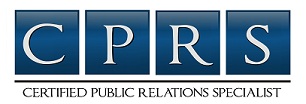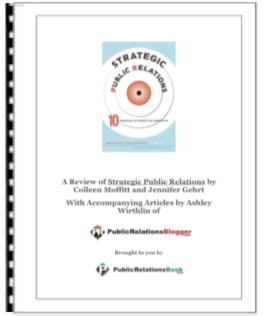________________________________________________________________________
 As the practice of public relations in China continues to mature, it seems appropriate to ask whether Chinese business managers - tutored as they have been by European, North American and other PR specialists - continue to apply major public relations emphasis to print and broadcast communications tactics. In other words, do they still see PR through the lens of simple publicity, as many in the West still do?
As the practice of public relations in China continues to mature, it seems appropriate to ask whether Chinese business managers - tutored as they have been by European, North American and other PR specialists - continue to apply major public relations emphasis to print and broadcast communications tactics. In other words, do they still see PR through the lens of simple publicity, as many in the West still do?
Or, do the best among Chinese managers -- as is also true for many businesses in Western economies -- realize they need true behavior change among their most important outside audiences leading directly to achieving their managerial objectives?
And, do they then take steps to persuade those key external stakeholders, who have the greatest impacts on their organizations, to their way of thinking, then move them to take actions that help their departments, divisions or subsidiaries succeed?
Let us presume that you are that business manager in China, and that you are well aware of the high-impact fundamental premise of public relations. Namely, “People act on their own perception of the facts before them, which leads to predictable behaviors about which something can be done. When that opinion is created, changed or reinforced by reaching, persuading and moving-to-desired-action the very people whose behaviors affect the organization the most, the public relations mission is accomplished.”
Managers who employ such a PR blueprint often see results such as prospects for their services or products starting to do business with them, fresh proposals for strategic alliances and joint ventures arriving on a regular basis, specifying sources starting to look their way, increases in visits to show rooms, and existing customers beginning to make repeat purchases.
If this approach to public relations appeals to you, before that PR blueprint is first employed, you need every member of the PR team assigned to your unit to agree that it’s crucially important to know how your outside audiences perceive your operations, products or services. Dig deep to ensure they REALLY accept the reality that perceptions almost always lead to behaviors that can damage your operation.
With that understanding achieved, It’s time to activate the PR blueprint and begin monitoring and gathering perceptions of those key external stakeholders by questioning members of that very important outside audience. Ask questions like these: how much do you know about our organization? Have you had prior contact with us and were you pleased with the interchange? How much do you know about our services or products and employees? Have you experienced problems with our people or procedures?
Fortunately, the PR people assigned to you are, by definition, already in the perception and behavior business, so they can be of real use for this opinion monitoring project. While professional survey firms can be brought in to handle the opinion monitoring, that can be expensive. But whether it’s your people or a survey consultant asking the questions, your objective is to identify untruths, false assumptions, unfounded rumors, inaccuracies, and misconceptions.
But which of the above “negativities” is serious enough that it obviously must become your corrective public relations goal because, unattended, it will lead to seriously hurtful behaviors? For example, clarify the misconception? Spike that rumor? Correct the false assumption? Fix those inaccuracies? Or yet another offensive perception that could lead to negative results?
With your public relations goal thus established, you can assure you’ll achieve it by picking the right communications strategy from the three choices available to you to show you HOW to reach your goal. Change existing perception, create perception where there may be none, or reinforce it. But be sure your new strategy naturally compliments your new public relations goal.
So what will your message emphasize when you address your key stakeholder audience to help persuade them to your way of thinking?
Select your best writer to prepare the message because s/he must put together some very special, corrective language. Words that are not only compelling, persuasive and believable, but clear and factual if they are to shift perception/opinion towards your point of view and lead to the behaviors you have in mind.
Happily, the next step is easy. You select communications tactics to carry your message to the attention of your target audience. Making certain that the tactics you select have a record of reaching folks like your audience members, you can pick from dozens that are available. From speeches, facility tours, emails and brochures to consumer briefings, media interviews, newsletters, personal meetings and many others.
Keep in mind that HOW one communicates often affects the credibility of the message, so you may wish to deliver it in smaller meetings and presentations rather than through a higher-profile media announcement.
You’ll soon feel pressure for signs of progress. And that will lead to a second perception monitoring session with members of your external audience. Employing many of the same questions used in the first benchmark session, you will now be watching carefully for signs that the communications tactics have succeeded in altering the offending perception in your direction. Remember that you can always accelerate the program by adding more communications tactics as well as increasing their frequencies.
This bears repeating - successful managers everywhere generally use every public relations weapon they can lay their hands on, and that includes strategic, rapid-fire print and broadcast tactics.
But those same competitive managers also know that above all, they need an aggressive blueprint such as this one that will deliver planned behavior change among their most important outside audiences leading directly to achieving their managerial objectives.
Please feel free to publish this article and resource box in your ezine, newsletter, offline publication or website. A copy would be appreciated at mailto:[email protected]. Word count is 1045 including guidelines and resource box.
Robert A. Kelly © 2004.
About The Author
Bob Kelly counsels, writes and speaks to business, non-profit and association managers about using the fundamental premise of public relations to achieve their operating objectives. He has been DPR, Pepsi-Cola Co.; AGM-PR, Texaco Inc.; VP-PR, Olin Corp.; VP-PR, Newport News Shipbuilding & Drydock Co.; director of communi- cations, U.S. Department of the Interior, and deputy assistant press secretary, The White House. He holds a bachelor of science degree from Columbia University, major in public relations. mailto:[email protected]. Visit his website.
Article Source.
Tags: international public relations, Chinese public relations, PR, public relations
|

International Public Relations: Questions for Managers in China
________________________________________
 As the practice of public relations in China continues to mature, it seems appropriate to ask whether Chinese business managers - tutored as they have been by European, North American and other PR specialists - continue to apply major public relations emphasis to print and broadcast communications tactics. In other words, do they still see PR through the lens of simple publicity, as many in the West still do?
As the practice of public relations in China continues to mature, it seems appropriate to ask whether Chinese business managers - tutored as they have been by European, North American and other PR specialists - continue to apply major public relations emphasis to print and broadcast communications tactics. In other words, do they still see PR through the lens of simple publicity, as many in the West still do?Or, do the best among Chinese managers -- as is also true for many businesses in Western economies -- realize they need true behavior change among their most important outside audiences leading directly to achieving their managerial objectives?
And, do they then take steps to persuade those key external stakeholders, who have the greatest impacts on their organizations, to their way of thinking, then move them to take actions that help their departments, divisions or subsidiaries succeed?
Let us presume that you are that business manager in China, and that you are well aware of the high-impact fundamental premise of public relations. Namely, “People act on their own perception of the facts before them, which leads to predictable behaviors about which something can be done. When that opinion is created, changed or reinforced by reaching, persuading and moving-to-desired-action the very people whose behaviors affect the organization the most, the public relations mission is accomplished.”
Managers who employ such a PR blueprint often see results such as prospects for their services or products starting to do business with them, fresh proposals for strategic alliances and joint ventures arriving on a regular basis, specifying sources starting to look their way, increases in visits to show rooms, and existing customers beginning to make repeat purchases.
If this approach to public relations appeals to you, before that PR blueprint is first employed, you need every member of the PR team assigned to your unit to agree that it’s crucially important to know how your outside audiences perceive your operations, products or services. Dig deep to ensure they REALLY accept the reality that perceptions almost always lead to behaviors that can damage your operation.
With that understanding achieved, It’s time to activate the PR blueprint and begin monitoring and gathering perceptions of those key external stakeholders by questioning members of that very important outside audience. Ask questions like these: how much do you know about our organization? Have you had prior contact with us and were you pleased with the interchange? How much do you know about our services or products and employees? Have you experienced problems with our people or procedures?
Fortunately, the PR people assigned to you are, by definition, already in the perception and behavior business, so they can be of real use for this opinion monitoring project. While professional survey firms can be brought in to handle the opinion monitoring, that can be expensive. But whether it’s your people or a survey consultant asking the questions, your objective is to identify untruths, false assumptions, unfounded rumors, inaccuracies, and misconceptions.
But which of the above “negativities” is serious enough that it obviously must become your corrective public relations goal because, unattended, it will lead to seriously hurtful behaviors? For example, clarify the misconception? Spike that rumor? Correct the false assumption? Fix those inaccuracies? Or yet another offensive perception that could lead to negative results?
With your public relations goal thus established, you can assure you’ll achieve it by picking the right communications strategy from the three choices available to you to show you HOW to reach your goal. Change existing perception, create perception where there may be none, or reinforce it. But be sure your new strategy naturally compliments your new public relations goal.
So what will your message emphasize when you address your key stakeholder audience to help persuade them to your way of thinking?
Select your best writer to prepare the message because s/he must put together some very special, corrective language. Words that are not only compelling, persuasive and believable, but clear and factual if they are to shift perception/opinion towards your point of view and lead to the behaviors you have in mind.
Happily, the next step is easy. You select communications tactics to carry your message to the attention of your target audience. Making certain that the tactics you select have a record of reaching folks like your audience members, you can pick from dozens that are available. From speeches, facility tours, emails and brochures to consumer briefings, media interviews, newsletters, personal meetings and many others.
Keep in mind that HOW one communicates often affects the credibility of the message, so you may wish to deliver it in smaller meetings and presentations rather than through a higher-profile media announcement.
You’ll soon feel pressure for signs of progress. And that will lead to a second perception monitoring session with members of your external audience. Employing many of the same questions used in the first benchmark session, you will now be watching carefully for signs that the communications tactics have succeeded in altering the offending perception in your direction. Remember that you can always accelerate the program by adding more communications tactics as well as increasing their frequencies.
This bears repeating - successful managers everywhere generally use every public relations weapon they can lay their hands on, and that includes strategic, rapid-fire print and broadcast tactics.
But those same competitive managers also know that above all, they need an aggressive blueprint such as this one that will deliver planned behavior change among their most important outside audiences leading directly to achieving their managerial objectives.
Please feel free to publish this article and resource box in your ezine, newsletter, offline publication or website. A copy would be appreciated at mailto:[email protected]. Word count is 1045 including guidelines and resource box.
Robert A. Kelly © 2004.
About The Author
Bob Kelly counsels, writes and speaks to business, non-profit and association managers about using the fundamental premise of public relations to achieve their operating objectives. He has been DPR, Pepsi-Cola Co.; AGM-PR, Texaco Inc.; VP-PR, Olin Corp.; VP-PR, Newport News Shipbuilding & Drydock Co.; director of communi- cations, U.S. Department of the Interior, and deputy assistant press secretary, The White House. He holds a bachelor of science degree from Columbia University, major in public relations. mailto:[email protected]. Visit his website.
Article Source.
Tags: international public relations, Chinese public relations, PR, public relations
Popular choices
- Non Gamstop Casino
- Mejores Salas De Póker
- Non Gamstop Casinos
- Siti Casino Online Non Aams
- Migliori Siti Casino Online
- UK Online Casinos Not On Gamstop
- Non Gamstop Casino Sites UK
- Non Gamstop Casino Sites UK
- UK Casino Not On Gamstop
- Casinos Not On Gamstop
- Online Casino
- オンラインカジノ
- UK Casino Not On Gamstop
- UK Casino Not On Gamstop
- Reputable Non Gamstop Casinos
- Casinos Not On Gamstop
- Best Non Gamstop Casinos
- Non Gamstop Casino
- Casinos Not On Gamstop
- Slots Not On Gamstop
- Non Gamstop Casino
|
| What did you think? |
Filed Under:
Chinese public relations,
International Public Relations,
PR,
public relations
Subscribe to:
Post Comments (Atom)






Comments (0)
Post a Comment